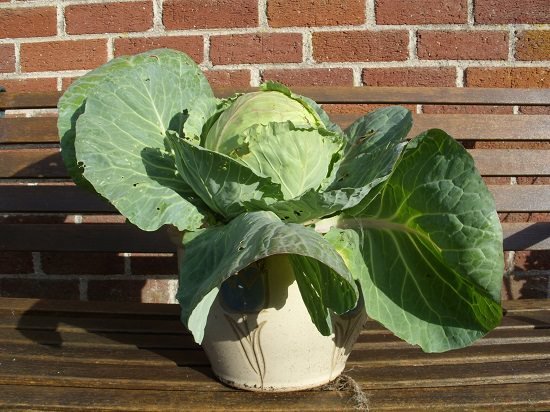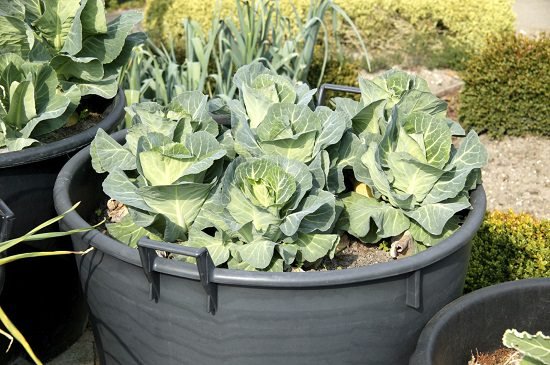Want to know How to Grow Cabbage in Pots? Learn the process in this detailed article and have a fresh supply of this nutritious vegetable in your cuisines!
Growing cabbage in containers is easy! You can do this in a small space and produce a fiber-rich, nutritious, and a low-calorie vegetable that can be cooked for a delicious meal or can be tossed directly into salads! It does very well in containers and growing it is fun as well! Let’s have a look at How to Grow Cabbage in Pots!
Check out our article on growing Cauliflowers in pots here!
Varieties of Cabbage for Growing in Containers
Savoy Cabbage: Also known as the curly cabbage, this variety produces mild-flavored, tender, and curly leaves. Compact varieties for a container are Savoy Ace and Savoy King.
Green Cabbage: Green cabbages are the most commonly used variety with pointed heads in dark green color. Compact varieties for a container are Stovehead, Blue Boy, Jersey Wakefield, Badger Ban, Head Blue, Ribbon Golden, Acre Flat, Dutch Rio Verde, and Green Boy.
Red Cabbage: These cabbages have purple-red colored heads enclosed with smooth leaves. Compact varieties for a container are Ruby Perfection, Red Acre, Red Ball, and Red Ribbon.
Choosing a Container
A 10-12 inches wide and deep pot is a good choice for growing cabbages. Only one cabbage plant will do best in one container, as planting more cabbage will result in smaller heads. The pot should have adequate drainage too. If you want to plant more cabbages in a single pot, go for wider containers.
Here’s how you can grow Malabar Spinach in pots!
How to Grow Cabbage in Pots?
Planting Time
When it comes to planting, pick a variety that fits the season and climate of the region you are living in. If you live in a frost-free climate, plant them anytime when the temperature is in the range of 50-85 F (10-30 C). At the time when it’s maturing, the ideal temperature is around 60-70 F (15-20 C). This ensures the best flavor and growth!
For warmer regions, that fall under USDA zones 9-11, you can sow seeds in fall and continue to sow them by the end of winter. For cooler zones, it’s a good idea to start sowing seeds from early spring to summer. This will allow you to have a bountiful harvest in summer or fall!
Propagation
Cabbages can be grown from both seeds and seedlings. You can procure seeds from a garden center or online stores. For growing cabbage from transplants, you can buy them from a nursery as well.
From Seeds
- Take a wide tray and fill it with seed starting mix or potting soil.
- Sprinkle the seeds on the soil and wrap it with a thin layer of potting mix.
- Water evenly but do not make the soil too soggy.
- Place the tray at a location where it gets 2-3 hours of daily sun. The required temperature for germination is 68-75 F (20-24 C). It will take 7-15 days.
- Transplant the seedlings after 4-6 weeks of germination, when they grow 3-4 inches tall with 3-4 sets of true leaves.
From Transplants
- Take a pot and fill it with well-draining soil.
- Make a 2-inch hole in the middle of the container, gently plant the seedling, and tap the surrounding soil.
- Maintain the moisture of the soil by watering at regular intervals.
- Provide the seedlings with 4-6 hours of sunlight. Avoid placing the plant in full shade as it will slow down the growth.
- Generally, it takes 60 to 105 days for cabbage heads to reach maturity. This might change depending on the variety you are growing.
Want to grow Wasabi in pots? Here’s everything you need to know!
Requirements for Growing Cabbage in Containers
Location
Do not place the container at a shady spot, as it will slow down the growth of the plant. Adequate sunlight is necessary if you are looking for large heads. Six or more hours of direct sunlight a day can do wonders for the cabbage growth! If the sunlight is intense in your region, you can also grow cabbage in partial sunlight.
Soil
With cabbages, you need to be a little careful with the soil. A quality, light potting mix, which is rich in humus and slightly clayey is going to do wonders for its growth! Cabbages grow best in moist soil, so choosing a substrate that holds some moisture, but also drains well, is always a good idea. Adding 1/4 part peat moss or coco peat in the potting mix is going to seal the deal! You can also use homemade potting soil, the recipes are here!
Watering
Watering cabbages regularly is the key, as they require moist soil to grow well. Do make sure that you’re never letting the soil grow dry when the seedling is maturing. The best way is to check the topsoil with your finger. If it’s dry 1 inch, water the plant. Overwatering also impedes its growth, which must be avoided.
Cabbage Plant Care
Fertilizer
A monthly dose of balanced liquid organic fertilizer is enough for optimum growth. You can also use 10-5-5 fertilizer or go for a diluted solution of fish emulsion, once every 2 weeks. If you are looking for more organic options, compost tea does well in increasing the nutrient levels of the soil.
Mulching
Mulching helps in maintaining moisture levels and temperature. It also prevents splitting even when the plant undergoes drought or overwatering. Keep in mind that sufficient watering avoids split heads in cabbages.
Pests and Diseases
Cabbages are prone to pests like cabbageworm, aphids, root maggots, and cabbage loopers. A strong stream of water will be enough to take care of them.
Clubroot, purple blotch, and black speck diseases can affect cabbages. They can be managed by increasing the pH level of soil by adding lime into it. Avoid watering on foliage to prevent purple blotch.
Check out our article on growing Swiss Chards in pots here!
How to Harvest and Store Cabbage?
- Using a sharp knife, cut the cabbage heads. Be careful not to damage the roots of the plants in the process.
- It’s always a good idea to cut 1-2 inches above the root level. Keep 2-3 outer leaves to prevent the edible part from getting damaged.
- Cabbages taste best when they are fresh. Cut and consume them immediately.
- They can be kept at room temperature for 1-2 days. For longer storage, keep them in a refrigerator. That’ll keep them good for 1-2 weeks.
How to Cook a Cabbage?
Cabbages can be steamed, boiled, fried, and braised. You can also fill, roll, and bake the whole cabbage leaves. Shred the leaves to make pickles or ferment them to make sauerkraut or kimchi.






Great information! Thank you for sharing….Do you have a book with all this instructions that includes all other vegetables and herbs? I live in zone 9 and I am new to gardening and want a detailed guide for any plant that can feed me and my family.
Thank you!
Proč nemám poškodit kořeny při odřezání hlávky? Oni si snad žijí svůj další život? Nebo že snad hlávka znovu doroste? To je vtip, že?